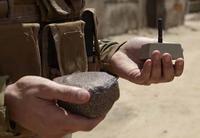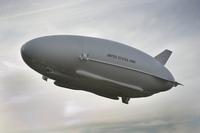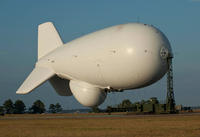-
DHS funds more tests of autonomous power buoy for ocean surveillance

Ocean Power Technologies (OPT) has entered into an agreement with DHS Science & Technology Directorate to perform a new round of in-ocean tests on the company’s Autonomous PowerBuoy to demonstrate its use for ocean surveillance
-
-
Cloud OS for the U.S. intelligence community
Cloud management specialist Adaptive Computingis partnering with the investment arm of the CIA, In-Q-Tel, to develop a cloud operating system for use by U.S. intelligence agency
-
-
Powerful new explosive could replace today's state-of-the-art military explosive
Borrowing a technology used to improve the effectiveness of drugs, scientists are reporting discovery of a new explosive more powerful than the current state-of-the-art explosive used by the military
-
-
Drones being used to track hurricanes

Federal hurricane trackers will start experimenting with unmanned boats and aircrafts to learn more about how to anticipate and track the movements of hurricanes; NASAand the National Oceanic and Atmospheric Administration(NOAA) are teaming up and using a pair of military-surplus Global Hawk spy drones, which are known more for spying on battlefields than chasing storms
-
-
New camouflage makeup shields soldiers from searing heat of bomb blasts
The new camouflage makeup protects the face and hands for up to fifteen seconds before its own temperature rises to the point where a first-degree burn, which is a mild burn, might occur; in some tests, the new face paint can protect for up to sixty seconds, which could be important in giving soldiers time to move away from blast-related fires and also for use by civilian firefighters
-
-
ONR’s augmented-reality project progresses

The Office of Naval Research (ONR) yesterday demonstrated the next phase of an augmented-reality project which will change the way soldiers view operational environments — literally
-
-
Unmanned sub-tracker to address a silent threat
The growing number of adversaries able to build and operate quiet diesel electric submarines is a national security threat that affects U.S. and friendly naval operations around the world; DARPA autonomous surface vessel will track and follow enemy subs for months
-
-
Soft robots for search-and-rescue and reconnaissance missions

Soft robots are useful because they are resilient and can maneuver through very constrained spaces, which makes them useful for search-and-rescue and reconnaissance missions; researchers show a soft robot made of silicone; it can walk, change color, and light up in the dark; it can even change temperature; it can do all of this for less than $100
-
-
U.S. Army trains rats in explosives detection

Landmines kill between 15,000 and 20,000 people a year, and continue to kill adults and children decades after a conflict ends; the U.S. Department of Defense currently relies on dogs as the animal of choice for explosives detection, but Pentagon researchers want to see whether rats can be trained to do the job; rats are smaller so they can search smaller spaces than a dog can, and are easier to transport
-
-
Underground spies to secure Indo-Pakistan border

With the discovery of a 400-foot long tunnel at the India-Pakistan Border, the IndianHome Ministry has decided to acquire Unattended Ground Sensors (UGS) that could be installed along the international border with Pakistan as an important line of defense
-
-
World’s largest blimp passes flight test

The world’s largest, lighter-than-air, optionally piloted aircraft — the U.S. Army’s Long Endurance Multi-Intelligence Vehicle (LEMV) – completed its first test flight in Lakehurst, New Jersey, the birthplace of the U.S. storied military airship past; the LEMV will provide improved ISR capabilities to the U.S. Army in the form of an “unblinking stare” over ground troops, ranging anywhere from one day to multiple weeks
-
-
First class of U.S. Army soldiers completed training with Raytheon's JLENS

JLENS uses a powerful integrated radar system to detect, track, and target a variety of threats, allowing military units to defend against threats, including hostile cruise missiles, low-flying manned and unmanned aircraft, large caliber rockets, and moving surface vehicles such as boats, SCUD-launchers, automobiles, and tanks
-
-
Silent Falcon solar electric unmanned aerial system unveiled
Silent Falcon UAS Technologies last week unveiled the much anticipated Silent Falcon solar electric unmanned aerial system (UAS) at the Association for Unmanned Vehicle Systems International (AUVSI) conference in Las Vegas
-
-
U.K. Ministry of Defense seeking IED sensors of the future
The U.K. Ministry of Defense (MoD) scientists are soliciting ideas from U.K. industry and academia to showcase their innovative ideas for detecting improvised explosive devices (IEDs); in particular, MoD is looking for sensors that can detect concealed IEDs, either worn by a person or hidden in a vehicle, buried by or in the roadside or hidden in a wall, box, bag, or another container
-
-
U.K. to help IRAQ destroy legacy chemical weapons

U.K. scientists will provide training which will support the Iraqi government’s efforts to dispose of remnants of the chemical weapons amassed during Saddam Hussein’s regime
-
More headlines
The long view
Bookshelf: Smartphones Shape War in Hyperconnected World
The smartphone is helping to shape the conduct and representation of contemporary war. A new book argues that as an operative device, the smartphone is now “being used as a central weapon of war.”
